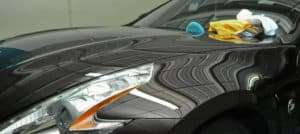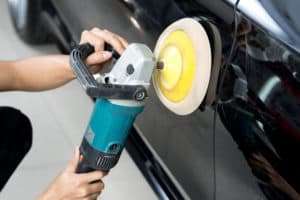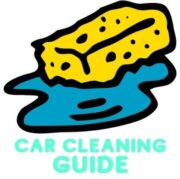Last Updated on November 14, 2023 by Chase Manhattan
Unleash the shine and luster of your vehicle with the art of waxing your car with a buffer! Whether you’re a beginner exploring the world of auto detailing or a seasoned professional seeking to optimize your technique, learning how to wax a car with a buffer can make a world of difference.
In this comprehensive guide, we’ll walk you through 5 simple yet effective steps that will help you achieve a mirror-like finish on your car, turning heads wherever you go.
From choosing the right wax to mastering the buffer, we’ve got you covered. So, buckle up and let’s embark on this exciting journey to transform your car into a gleaming beauty on the road. Get ready to experience the magic of a well-waxed car that not only looks stunning but also ensures longer paint life!
Saddle up, keep reading, and let’s get into it!
- What Is The Two Bucket Method To Wash Car Properly - July 2, 2021
- 5 Best Car Seat For Grandparents That Impress Your In Laws - May 18, 2021
- 5 Best Rooftop Cargo Box For Audi Q5 [Review & Buying Guide] - May 11, 2021
Here’s a brief guide on waxing a car with a buffer, like a professional, in a few short steps:
- Get the Materials You Need
- Prepare the Surface
- Apply the Wax and Polish
- Buff the Surface
- Remove the Wax
Although the process can be intimidating, especially for beginners, it is easy to learn how to wax a car with a buffer. Read on to find out the best method for waxing your car with a buffer, and some supplementary information you’ll need throughout the process.
[How to Prevent Water Spots on Your Car’s Paint Job]
Quick Navigation
How To Wax a Car With a Buffer
Waxing your car using a machine buffer is not a difficult process. It will actually save time compared to the hand car waxing process, while also allowing you to fix a keyed car should you need to, but there are some precautions to take so you know you’re doing it correctly.
Before you start to wax your car, you’ll need to make sure you have the required materials and the proper knowledge before you prepare the entire surface in order to achieve the best results. Waxing your car with a buffer is one of the most necessary skills to have as both a hobbyist and professional, it’s up there with knowing how to clay bar your car to remove embedded dirt. Otherwise, you run the risk of discovering one of the common causes of car scratches, improper preparation and procedure.
1. Get the Materials You Need
To wax a car, you will need:
- Machine Buffer/Polisher. If you don’t have one yet, check out our best car wax buffer buying guide. Applying wax with a mechanical buffer is much easier.
- Finishing Pad. You’ll attach this to the machine polisher to apply the wax; be sure to buy a size that fits. Also known as an applicator pad or waxing pad.
- Liquid Wax. You can also consider spray wax and paste wax
- Microfiber towels buff and protect your clear coat
- Cover or shade to avoid direct sunlight
2. Prepare the Surface

Before you begin waxing, you’ll need to ensure the surface is ready to be waxed. Use clean water to rinse your car thoroughly. You should also consider removing embedded dirt using a clay bar. While the clay bar process can be time consuming, it will save your clear coat from any unnecessary scratches. When using a clay bar, be sure to lubricate the surface because It can damage your paint when used on a surface that is completely dry. Throughout your car wash, pay extra attention to frequently dirty areas to remove any unseen contaminants.
You should wax your car in the shade or in a garage. This will help you avoid direct sunlight, which can dry your wax too quickly. Be sure not to use too much wax to compensate.
Be sure to double-check that the surface is clean, as the remaining dirt could cause scratches or leave swirl marks. Use a soft cloth with some elbow grease when removing any common dirt, like bird droppings, so as not to damage your car surface. Be sure to go in the same direction, as horizontal scratches are easier to repair than those made from circular motions.
The next step will be an application of a high quality car wax or a liquid paint sealant.
[How to Remove Scratches From Black Plastic Bumpers]
3. Apply the Car Wax
Before applying wax to the car surface, do note there are a few types of wax in the market: liquid wax, spray wax and paste wax.
The easiest to apply option is the liquid version, while even though the paste wax application is harder and takes more time, it has a longer lasting outcome compared to the other 2 options.
Whichever option you choose, you will need to pick a foam finishing pad to apply wax. The pad should be absorbent and soft, yet firm enough to handle the power buffer pressure.
Begin by attaching the applicator pad to the machine buffer. Squeeze several dots of liquid wax onto the buffer pad in a circle, then put a large dot in the middle. Be sure to always use a clean applicator pad during any step of this process.
[Related: How To Clean Polish Pads]
Next, apply the wax lightly onto several spots on the paint surface you are working on while the machine buffer is turned off. This will spread it around the surface, preparing it to be buffed.
4. Buff the Surface

Turn on the machine buffer and wax the section using light pressure in long, straight lines with sweeping strokes.
Quickly pass over the section two or three times but make sure there is enough visible wax on the surface to avoid damage.
Additionally, avoid using too much pressure because you don’t want to damage the paint. The goal is to apply an even, thin coat of wax.
The purpose of the wax is to provide sealed protection against light scratches or water spots.
[Removing Ceramic Coating Streaks]
5. Remove Wax Residue
When the wax has dried (check your wax product for more information), use a clean microfiber towel or mechanical buffer to remove it from the surface. Use soapy water if needed. If removing wax from a windshield, heavier duty chemicals may be required.
Helpful Tips:
- Move in straight lines when wiping away wax to avoid scratching.
- Use one clean microfiber towel for removing most of the wax, then another for cleaning off any remaining wax.
- The wax should be at a thin layer where you can still see the car paint color
How To Video
[The Exhaustive Guide to Washing Your Car Without A Hose]
How Often Should You Wax Your Car?
The answer will vary for every individual when it comes to how often you should be waxing your car. In other words, how often you wax your car depends entirely on the circumstances in which you live.
For example, does it stay outside or is it garaged? Is it your daily driver, or does it only come out to play on the weekends? What kind of car wash soap do you use – one that will strip wax, or one that won’t?
Will Waxing With A Buffer Remove Swirl Marks?
Waxing a car with a buffer can help reduce the visibility of swirl marks, but it typically does not remove them entirely.
Swirl marks are minor scratches on your car’s paint surface, and while wax can fill in these scratches to some extent, it is not a permanent solution.
To remove swirl marks completely, you’ll need to use a dedicated swirl remover or a polishing compound, followed by waxing to protect the paint and maintain a glossy finish.
What’s Better To Use With A Buffer: Liquid Wax or Paste Wax?
Both liquid wax and paste wax can be used with a buffer to achieve a great finish on your car. However, each type has its own advantages and disadvantages:
Liquid Wax
- Easier to apply and spread evenly with a buffer
- Faster drying time
- May not provide as long-lasting protection as paste wax
Paste Wax
- Thicker consistency, which can result in a more durable layer of protection
- Longer-lasting shine and protection
- May require more effort to apply and buff out with a buffer
Ultimately, the choice between liquid wax and paste wax depends on your personal preference and the specific needs of your car. Both types can provide excellent results when used with a car wax buffer.
What’s The Difference Between Wax and Car Polish?
Wax and car polish are often confused, but they serve different purposes in maintaining your car’s appearance. Here’s a breakdown of their key differences:
Car Wax
- Provides a protective layer on the car’s paint surface
- Shields the paint from environmental contaminants, UV rays, and minor scratches
- Enhances the shine and gloss of the paint
- Typically made from natural or synthetic materials, such as carnauba or polymers
Car Polish
- Contains mild abrasives that help remove minor imperfections, such as swirl marks, oxidation, and fine scratches
- Restores the paint’s clarity and depth of color
- Prepares the surface for wax application by smoothing it out
- Does not provide protection like wax; instead, it improves the paint’s appearance
In summary, car polish is used to correct minor paint imperfections and improve the paint’s appearance through its paint correction properties, while car wax is used to protect the paint and return it to its showroom shine.
For optimal results, it’s best to use both products in a two-step process: polish first to remove imperfections, then apply wax to protect and maintain the paint’s finish.
Best Wax to Use with a Machine Buffer
Meguiar’s Ultimate Liquid Wax
[Turtle Wax: Wax and Dry Review]
The easiest way to apply wax using a machine buffer or polisher is by using a liquid wax – in my personal experience/opinion/preference. When compared to other car waxes, like wax paste or carnauba wax, liquid wax is the easiest type of car wax to apply to an applicator pad and will make it easy to spread a thin, even coat across the surface of your car.
Although you may use whatever liquid wax you prefer, Meguiar’s makes a great liquid wax which is commonly used with machine polishers.
Can You Damage A Car With an Electric Buffer?
Yes, it is possible to damage your car when using an electric buffer. This is why it’s important to follow all the steps outlined above in addition to using clean, high-quality materials only.
Why Is Waxing Your Car Important?
It’s important to wax your car in order to fully protect the color coats of paint underneath the clear coat. Over time, UV rays, bird droppings, bug splatters, and accumulated dirt will wear out the clear coat on your car; when this happens, the color will chip and fade over time.
In other words, waxing your car frequently is paramount in maintaining the resale value of your car and preserving it’s visual appearance through the benefits of waxing your car.
Things to Remember
- Buy proper, quality materials
- Fully clean your car before waxing
- Work in the shade or inside a garage
- Use multiple microfiber towels to avoid leaving wax residue behind
- A dual-action orbital polisher is best for beginners and is ideal for waxing
- It’s important to wax your car frequently to keep it in great shape
FAQs
Is It Better To Apply Wax With A Buffer?
In pretty much every way, yes. Applying was with a buffer or polisher is twice as efficient, in terms of time. It also reduces the risk of scratching or swirling your paint when waxing by hand.
Do You Buff A Car After Waxing?
Yes, you must buff your car after waxing it. The buffing step of the process evens out the coating of wax to efficiently seal and protect your car’s paint job.
Can You Damage Your Car With A Buffer?
Yes, you can damage your car with a buffer if you don’t know what you’re doing. By following the steps we’ve outlined above, you’re significantly reducing your chances of damaging your car while increasing your chance of having a spot free, shining finish!
How Long Should You Leave Wax On A Car Before Buffing?
I prefer to apply the wax across the entire panel that I’m working on, before I start buffing it. There’s no reason to buff the wax within a particular time frame, as long as you do not let it sit in clumps for extended periods of time.
How Do You Wax A Black Car?
You can wax a black car the same way as you would any other vehicle, just be more cautious as black paint is more likely to show minor scratches and imperfections.
How To Remove Car Wax From Door Jambs
Since most machine buffers will not fit inside the door jamb, I recommend using a soft brush to buff the area instead. Alternatively, you can use a soft microfiber cloth to work your way inside the area.


